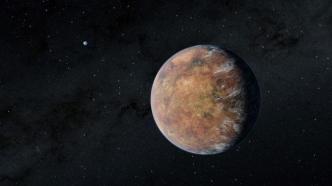

The Hubble Space Telescope captured an image of the dust and debris plume ejected after the DART spacecraft slammed into the asteroid Dimorphos. Image credit: NASA
On September 26, NASA's Double Asteroid Redirection Test (DART) spacecraft slammed into Dimorphos, a smaller asteroid in a near-Earth binary asteroid system, in an attempt to change its orbit. This is the world's first test mission designed to defend Earth from the threat of an asteroid strike.
On Oct. 11, NASA confirmed the mission was a success — the impact of the DART spacecraft pushed Dimorphos toward its companion star Didymos and shortened the former's nearly 12-hour orbital period by 32 minutes.
It is reported that the deflection caused by the impact was far greater than expected. NASA said before the impact that a 73-second reduction in the orbital period would represent a successful mission. Most astronomers predict that the impact could shorten the orbital period by 10 minutes. Obviously, the "achievement" of 32 minutes was unexpected and surprising. This may be because Dimorphos was formed more like a pile of rubble than a solid rock, so loose fragments ejected by the impact pushed it away from its original location.
"This shows that kinetic impact is a viable approach to planetary defense," said Cristina Thomas, a planetary scientist at Northern Arizona University and leader of the mission observation team.
NASA chose to conduct impact testing in the binary system for two reasons: First, Didymos, which is 780 meters in diameter, acted as a gravity anchor during the impact, ensuring that Dimorphos would not be inadvertently bounced toward Earth. The second is a pair of asteroids that are fixed in orbit, making it easier for scientists to measure how much the impacted asteroid is deflected relative to its partner.
When viewed with telescopes from Earth, the two asteroids appear as a single point of light, but when one of the objects overlaps in front of the other, the brightness drops by about 10 percent. By observing the time interval between the blinks so formed, scientists can calculate the orbital period of Dimorphos. If the interval between flashes is significantly shorter after impact, it means one of the asteroids is close to the other, proving that the spacecraft's impact successfully deflected it from its original orbit.
Estimating the degree of orbital deviation through impact-induced jets requires multiple systems and multiple detailed observations. In addition to space telescopes, dozens of observatories on Earth are observing the impact. Scientists analyzed data from three telescopes in Chile and one in South Africa to calculate the new orbital period. Two other telescopes confirmed the above results through radar observations.
All in all, the above early data confirms that humans have the ability to protect Earth, at least against relatively small asteroid "attacks."
These "space rocks" have been the focus of planetary defense experts because they are thousands of times more likely to hit Earth than the asteroid that wiped out the dinosaurs. But finding and intercepting these "dangerous molecules" when they're far enough from Earth may require more investment in early detection systems research. (Original title "The operation period is shortened by 32 minutes, the first time humans successfully change the orbit of an asteroid")

